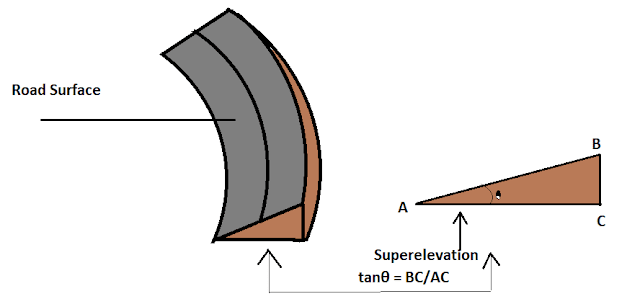Maximum And Minimum Superelevation as Per I.R.C
When a vehicle is moving on a curved path it is subject to an outward force known as centrifugal force. In order to counteract the effect of centrifugal force, the outer edge of the pavement is raised with respect to the inner edge. This transverse inclination provided to the pavement surface is known as superelevation.

Superelevation is generally denoted by ‘e’ and expressed as the ratio of the height of the outer edge will respect to the inner edge to the horizontal width.
Superelevation (e) = BC/AC = tanθ
Maximum Superelevation
As per IRC, the maximum superelevation in plain and rolling terrain and in the snowbound area is 1 in 15 or 4° or 7 %. On hill roads not bound by snow, a maximum superelevation up to 10% has been recommended by IRC.
Maximum superelevation is provided to prevent the vehicle from being overturned. So, we can say, it is the maximum percentage of angle allowed for the road to prevent the vehicle from being overturned.
Minimum Superelevation
The road surface should have a minimum camber to drain off rainwater. If the calculated superelevation is equal to or less than the camber of the road surface, then the minimum superelevation to be provided on the horizontal curve may be limited to the camber of the surface. It is usually 2 to 4%.
The minimum super elevation is provided mainly for the drain of rainwater effectively. So, we can say, it is the minimum angle allowed for the road to drain off rainwater.
Read Also: